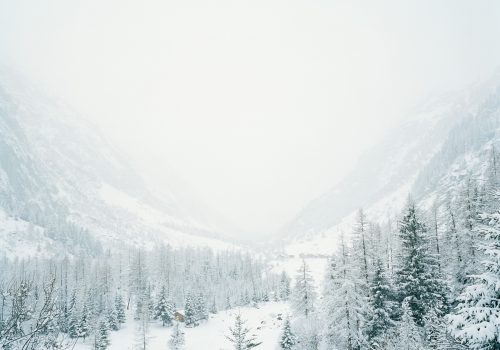Shot in the alpine landscape that inspired Mary Shelley’s classic novel, Chloe Dewe Mathews’ photographic series In Search of Frankenstein juxtaposes snow-covered mountains with a network of eerie subterranean bunkers, built in the 1960s to shelter the entire population of Switzerland in the event of a nuclear disaster.
The project was conceived during a residency at the Verbier 3-D Foundation in 2016, when the artist discovered that Shelley’s manuscript was started during an unusual holiday on the shores of Lake Geneva. The ominously wet weather conditions of 1816 – the ‘Year without Summer’ – forced Shelley and her companions to stay indoors day after day, dreaming up ghost stories, from which Frankenstein’s monster emerged.
Dewe Mathews photographed the region that had inspired the eighteen-year-old author, exploring miles of underground corridors and vast melting glaciers that seemed to offer parallels between Shelley’s prophetic socio-environmental concerns and the anxieties of our time. In Search of Frankensteinpresents a contemporary sublime, which affords this monumental piece of literature fresh resonance, two hundred years after it was first published.
The artist book In Search of Frankenstein – Mary Shelley’s Nightmarehas just been published by Kodoji Press. The book combines Dewe Mathews’ photographs with reproductions of the Geneva Notebook: the first half of Mary Shelley’s original manuscript.
In Chloe Dewe Mathews own words:
In 2016, the Verbier 3-D Foundation invited me to do an artist residency in the Val de Bagnes, Switzerland. While researching the area’s history I came across the extraordinary story of the “Débacle du Giétroz”. Between 1816 and 1818, the Giétroz Glacier built up to form a great dam of ice. Under mounting pressure, it exploded to release gallons of water that tore through the valley, travelling all the way to Lake Geneva and devastating everything in its path.
This disaster was caused by a peculiar climactic event. In 1815, the eruption of Mount Tambora on an Indonesian island emitted a huge, impenetrable cloud of ash that blocked out sunlight over much of the world, causing temperatures to plummet. The effects spread from Asia to North America and Europe, leading to crop failure, starvation and mass migration. 1816 became known as ‘the Year Without Summer’.
It was at this time that Mary Shelley, her husband Percy Bysshe, Lord Byron and John Polidori were holidaying on the shores of Lake Geneva. The unusual weather conditions meant that instead of spending the summer swimming or rowing on the lake, the poets stayed indoors, reading books and watching the relentless rain. One afternoon, Lord Byron challenged each member of the party to write a ghost story. Mary Shelley was only eighteen at the time. Intimidated by the older, more experienced, male group, she spent days wracking her brains for an idea, a starting point, but nothing came. One night as she lay down to sleep and a series of horrific images flickered before her closed eyes. She was overwhelmed, if only she could write a story as terrifying as her waking dream. It suddenly became clear; to write the ultimate ghost story all she needed to do was recount the events she had witnessed in the dream; the story that had terrified her so deeply. Over the coming weeks, this transcription became the first draft of Frankenstein.
After making the connection between Geneva, the Swiss Alps and the epiphany that inspired Mary Shelley to create her iconic work, I packed my old copy of Frankenstein and took it with me on my first trip to Switzerland. I carried it up to the glacier and read it on the snowy mountainside. Some of the most memorable scenes are set in the wild icy landscapes of the Swiss Alps. My eyes scanned the barren white lands for Frankenstein’s creature, crossing the glacier at ‘super-human speed’. I imagined catching a darting figure in my peripheral vision or coming across a makeshift cabin that had sheltered the fugitive for the night. I looked at these beautiful, fragile expanses, searching for Frankenstein’s creature but realized I was in fact looking at another incarnation of the beast. The grey bulk of melting glacier became, like Frankenstein’s creation, an embodiment of human folly.
Back in Verbier, I was told about a network of nuclear bunkers deep inside the mountain, built on a huge scale by the Swiss government in the 1960’s as a place of refuge for the entire population in the event of a nuclear disaster. I arranged to visit this eerie facility, wondering as I went, about the likelihood of such a catastrophe ever happening. It was, of course, a threat that we humans had created. The stark aesthetic contrast between these man-made fortresses and the fragility of the snow-covered slopes seemed to chime with Mary Shelley’s nightmarish vision, and became the substance of my project.
Over a year later, back in England, I was given access to Mary Shelley’s original manuscript at the Bodleian Library (part of which is known as the Geneva notebook). It is hard to describe my excitement at the intimate experience of seeing her frantic spidery handwriting: the corrections and additions that made up the initial draft of the novel. The questions she was asking in her book seem just as relevant today. All these discoveries fed into, and helped form this body of work, which I hope will resurrect some of the same questions Mary Shelley was asking about hubris, human nature, man-made disaster and our continuing destructive impact on the natural environment.
















